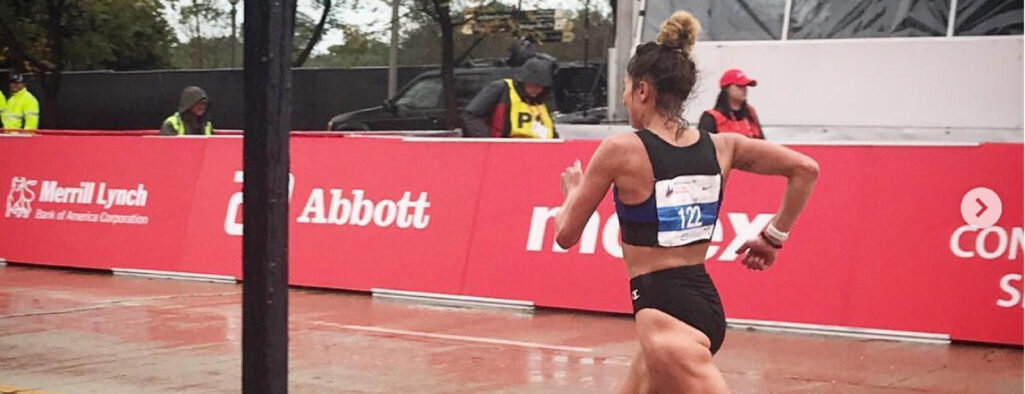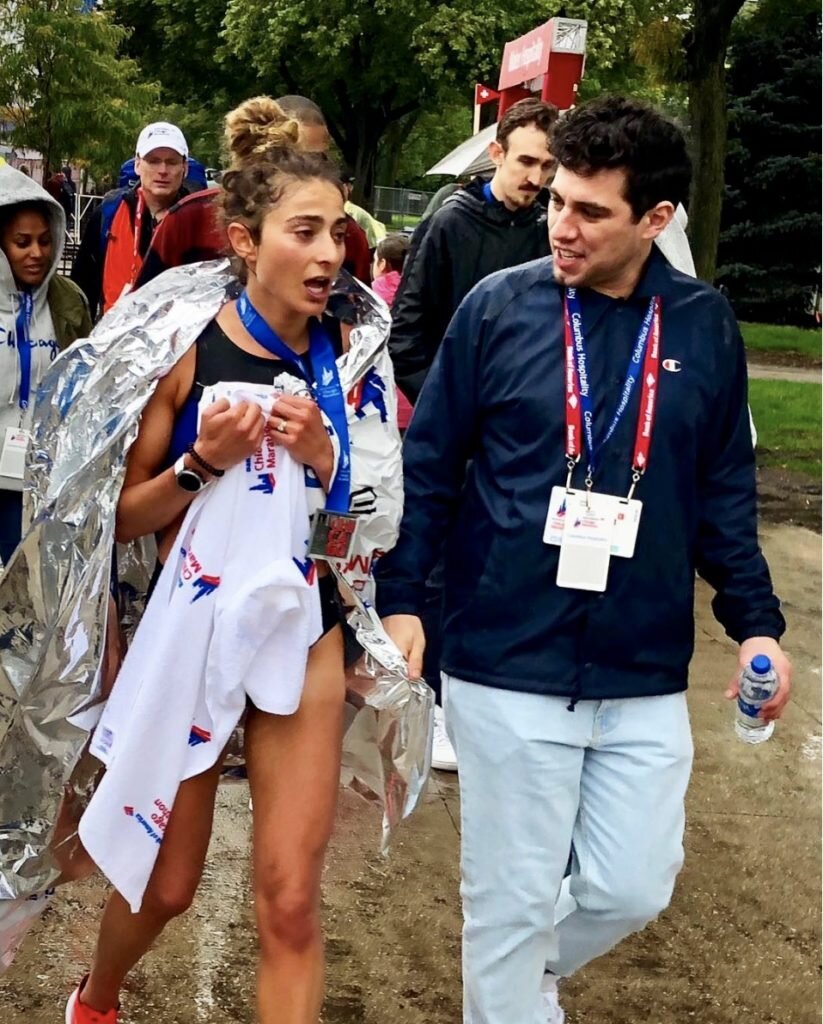Alexi Pappas: Lessons Learned from my First Marathon
By Alexi Pappas / TrackTown USA
Since I ran my first race, a 5k fun run attached to a larger marathon in Napa, Calif., I have understood the marathon to be the most classic distance race. I remember watching my dad cross and collapse across the finish line of the marathon later that day with a time of just over 4 hours, and I remember how proud but tired he looked.
When I had the honor of sitting in the lead car for the New York City Marathon, I had the chance to see thousands of people cheering for loved ones alongside the course. I saw the leaders finish, and then, hours later after a dinner party at Tavern on the Green, I returned to the finish line and saw the very last runner complete her race with a small crew of marathon employees cheering her on. I had considered racing a marathon last year and even two years ago, but decided to wait until the moment felt right – and this year at the Chicago Marathon, I decided the time was right to finally brave this epic event myself.
The 2018 Chicago Marathon was my first serious race since the 10,000 meters at the 2016 Rio Olympics (I’m not counting the 5k Turkey Trot I ran in November 2016, which was literally the last time I stepped up to a starting line). I took significant time away from competition to deal with the first big injury of my life, and also to give myself some time to transition to marathon training. My training cycle building up for Chicago had gone very well, but my coach made sure I was aware of what the specific goal of this marathon was: to race, of course, but most importantly, to gain an understanding of the marathon itself. Mentors had told me that the marathon could be considered its own sport entirely different than track. But until I experienced it myself, I couldn’t quite fathom what this truly meant.
Before the race, I spent time visualizing the race and imagining parts where I thought I might struggle. I imagined myself pushing through the rough patches and continuing on. I visualized myself executing the race plan I developed with my coach. I imagined myself excelling in this new event. I even spoke to young athletes at an event in Chicago a few days before the race about this very concept: about how if you visualize yourself not giving up then you are more likely to succeed. But no amount of visualizing could have possibly prepared me to truly understand what I was about to endure.
“I TOED THE START LINE LIKE GOOD PASTA: SLIGHTLY UNDERCOOKED. MAYBE TOO UNDERCOOKED, BUT THAT IS ALWAYS BETTER THAN OVERCOOKED.” – ALEXI PAPPAS
I toed the start line like good pasta: slightly undercooked. Maybe too undercooked, but that is always better than overcooked. I felt the same pang of excited nervousness that I missed so much during my time off from racing. I was at the very front of the start line, with thousands of people behind me all about to wrestle the same monumental task together. I thought for a moment about how running is a team sport masked as an individual sport. Then the gun went off, and we went.
The first unexpected thing I noticed was my GPS watch didn’t work properly amongst all the other GPS-clad runners and tall buildings. I would need to split my watch manually and try to run by feel – but for me, coming off such a long break, running 5:45 per mile pace wasn’t as intuitive as it used to be. I hadn’t run consistently at that pace so often, especially because my training was done at high altitude (8,000 feet), where we generally train much slower. But I stayed calm and tucked into a pack. I found a group of men to run with, but quickly found that, like me, they were also having trouble sticking to one pace. Then it began to rain! I felt excited and grateful to be racing, but increasingly overwhelmed by what became a much more complicated race.
Then, about 10 miles into the race, I began to feel a weakness in my leg that had previously been injured. My hamstring was tugging and I felt my mobility decrease with each passing mile. The feeling wasn’t pain, more of a limitation, but it was unexpected and restrictive nonetheless. I’ve experienced moments of pain before in races, where it was up to me to push through, but this was different. It wasn’t a matter of pain, it was a matter of mechanical limitation. Apparently, though I was healthy in every other way, my hamstring was not yet strong enough to carry me at those paces for a marathon distance. This limitation had never revealed itself in practice, but now – at a distance beyond anything I’d ever raced before – I was forced to deal with a challenge I had not anticipated or prepared for at all.
Inside, I had a moment of realization where I understood I was not going to physically be able to achieve the goal I had set for myself. It was not about mentally pushing myself to do it – I’m no stranger to pain but I literally could not run faster than I was running. But that didn’t mean I needed to stop. I could feel that my hamstring could keep going, just not anywhere near the pace I planned. I had a choice: clock a time I wasn’t hoping for and perhaps finish in a place that could be seen as embarrassing, or drop out. Some elite runners will drop out of a race so that they don’t finish with a “bad” time on their record. This is the easy way out. I thought about how I might feel ashamed to finish a race with a performance that is beneath what I am capable of and what people expect from me. What would be the worse failure: running slow or dropping out? Does crossing the line but not achieving your race plan mean you are a failure? Or is it better to stop so you can never know for sure how you would have finished? There is a lot of time in a marathon to think.
Alexi Pappas running the 2018 Chicago Marathon. (Photo: Alexi Pappas)
But then I opened my ears to the voices around me. All around me, people were cheering for me, yelling “go bravey!” I let those voices flood my mind for a mile or two and felt the sudden understanding that although I was no longer able to achieve my initial goal, I could still accomplish a goal. I could change my goal mid-race and redefine what success meant for me in this race. I changed my goal to simply focusing on finishing the race.
My goal was no longer to race the marathon but to finish it. Simply continuing to put one leg in front of the other became the ultimate challenge for me. I felt a sudden calmness – I felt that I was suddenly folding into the thousands of people behind who all had the very same goal. The Chicago Marathon is many people’s first marathon, and I imagined I was not the only one who would be beyond proud to finish the thing.
Every runner who passed me cheered for me, and I no longer felt ashamed. I felt grateful for their support, because it actually felt real. I felt like I was experiencing the world in slow motion. The race was long, so very long. But sure enough, 16 miles turned to 17, 18 to 19 … and so on. I focused on things outside of myself: the crowds, the city of Chicago, and the teens I’d told nights before that if chasing a goal were easy, anyone would do it. I told them I’d been the worst on my team before, which was the case when I first went to college. I worked my way up slowly. I understood at mile 22 that the marathon might feel the same way. I have always been a late bloomer and nothing has ever come easy for me. But when I hang in there, things do come. I know the marathon is like that too.
I will never forget the feeling when I saw the finish line. Alongside the finishing straightaway were all the people I loved: my family, my husband, my coach, my team, and even my best friend since I was two years old. I felt overwhelmingly proud because I knew I accomplished my goal. I also felt a twinge of sadness that I had to let go of my initial goals – but I knew that was because of a factor beyond my control – my hamstring – and I had no choice.
That’s the tricky thing: determining when you should re-frame your goal versus when you need to dig deep and double down on it. You control what you can control, and you can’t control what you can’t control. For example, it started pouring down rain in the middle of the race – another uncontrollable factor. If that had been the only uncontrollable thing to happen to me, I still would have needed to adjust my goal to account for the slower pace due to rain. The things you can control – pain, determination, fueling – those are factors that, ideally, should never cause you to re-frame your goal. Those are things you work hard to perfect and conquer. These challenges are characteristic of all the races I’ve ever run. I’ve always had to make choices to not give up. But how do you know the difference between reframing your goals versus giving up?
Alexi Pappas and Jeremy Teicher catch up post-marathon. (Photo: Alexi Pappas)
It is incredibly important for us as athletes to understand the difference so that we can properly assess our decisions during a race and maintain our integrity to our goals. The most important thing as athletes is to have integrity with our goals: which simply means that we always want to try our best. If trying our best is compromised by things within our control, this is a problem, but if our best is compromised by things out of our control, then doing our best simply means performing to the best of our ability within the new limitations. So even if your goal changes – your pace is slower due to rain – your integrity is still maintained.
At the Chicago Marathon, I was fighting two limitations that were totally out of my control: the rain and, more urgently, my hamstring. In this situation, trying my best meant reframing my goal. I still felt sad about not being capable of achieving what I set out to do, but I was happy I had integrity as an athlete nonetheless. And what made this experience particularly special to me was that I was not alone in this endeavor. In the Chicago Marathon, there were thousands of people all trying to do the same thing: to run with integrity. I sensed that as I was pushing myself, so was everyone else around me at the very same time. I understood that this experience connected me not only to the runners around me, but also to all marathoners who have ever crossed the finish line.



